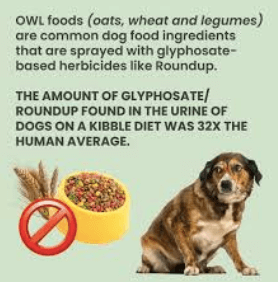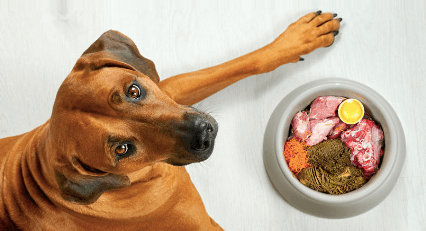Dangerous endocrine disruptors are commonly found in dog food.. According to the National Institute for Environmental Health, endocrine disrupters are defined as natural or man-made chemicals that can disrupt the body's endocrine system, which is responsible for regulating the body's growth, metabolism and development and control and influence almost every cell in the body.
Endocrine disrupters include Bisphenol A (BPA), pesticides such as glyphosate, additives like BHA and BHT, food dyes, synthetic preservatives, and seed oils.. Endocrine disruptors can mimic hormones, block hormones or alter hormone production and metabolism. Consumption of endocrine disruptors are linked to reproductive and developmental problems as well as obesity, diabetes and certain cancers in both humans and dogs alike. Unfortunately, dangerous endocrine disruptors are commonly found in dog food.
Bisphenol A (BPA) is chemical used in manufacturing polycarbonate plastics and epoxy resins for products like hard plastic containers, food can linings and dental sealants. While BPA is not directly used in kibble formulations, it can be found in packaging in dry and wet food, but more so in canned. Unfortunately, there is a risk of contamination through manufacturing or from environmental exposure, even if the food doesn't come directly in contact with plastic. BPA is a dangerous endocrine disruptor commonly found in dog food.

BHA, or butylated hydroxyanisole and BHT, or butylated hydroyotoluene, are synthentic antioxidants used in as preservatives in many foods, including kibble to prolong shelf life stability, and they are also endocrine disruptors that are commonly food in dog food. According to Purina, "BHA (Butylated Hydroxyanisole) and BHT (Butylated Hydroxytulene) are two additives that prevent the oxidation of fatty substances and the alteration of color and other qualities of the products to which they are added."
As stated by the Environmental Working Group, according to the good old FDA, both BHA and BHT are generally recognized as safe, despite the National Toxicology Program having classified BHA as "reasonably anticipated to be a human carcinogen." The European Union classifies BHA as a potential endocrine-disrupting compound because animal studies show how BHA chemically binds to hormone receptors and disrupts normal endocrine function particularly reproduction and fertility. At the American Conference of Governmental Industry Hygienists suggests that BHT is a respiratory irritant in humans, while not a carcinogen, like BHA. Animal feeding studies suggest exposure to BHT was linked with endocrine disruption associated with the liver and kidneys. BHA and BHT are dangerous endocrine disruptors commonly found in dog food.
Brands and formulations that contain BHA or BHT that we recommend avoiding completely:
- Kibbles'n Bits Mini Bits Beef, Vegetable & Apple Small Flavors Small Breed Dry Dog Food: Animal Fat (BHA/BHT Used as a Preservative)
- Kibbles'n Bits Triple Steak Flavor Dry High Protein Dog Food: Animal Fat (BHA/BHT Used as a Preservative)
- Pedigree Complete Nutrition Grilled Steak & Vegetable Flavor Dog Kibble Adult Dry Dog Food: Animal Fat (Source Of Omega 6 Fatty Acids [Preserved With Bha & Citric Acid])
- Pedigree High Protein Beef & Lamb Flavor Dog Kibble Adult Dry Dog Food: Animal Fat (source of Omega 6 Fatty Acids [preserved with BHA and Citric Acid])
Food dyes are also dangerous endocrine disruptors that are commonly found in dog food. There are two types of food colors - food dyes and lake colors. Food dyes are made from petroleum or crude oil. Organic food lake pigments are made from natural pigments and inorganic lake pigments are made from metallic sources. According to this article, "food dyes, synthesized originally from coal tar and now petroleum, have long been controversial because of safety concerns. Many dyes have been banned because of their adverse effects on laboratory animals or inadequate testing." Consumption of these artificial food colorings, like the amount food in eating kibble everyday are dangerous endocrine disruptors commonly found in dog food and are linked to disease.
The following list contains just a few brands and blends that contain food dyes and we recommend avoiding at all costs:
- Cesar Filet Mignon Flavor & Spring Vegetables: FD&C Red No. 40, FD&C Yellow No. 5, FD&C Blue No. 22
- Kibbles 'n Bits Original Savory Beef & Chicken Flavors: FD&C Yellow No.5, FD&C Yellow No. 6, FD&C Red No.40, FD&C Blue No.1
- Pedigree High Protein Adult Dry Dog Food Beef and Lamb Flavor Kibble: FD&C Yellow No. 6, FD&C Red No. 40, FD&C Yellow No.5, FD&C Blue No. 2
- Pedigree Complete Nutrition Adult Dry Dog Food Grilled Steak & Vegetable Flavor Kibble: FD&C Red No. 40, FD&C Yellow No. 6, FD&C Blue No. 2
The following list contains just a few brands and blends of treats that contain food dyes and we recommend avoiding at all costs:
- Dingo Dental Sticks Tartar Control Dental Dog Treats: FD&C Blue No.1, FD&C Yellow No.5
- DreamBone Twist Sticks Chicken Chew Dog Treats: FD&C Red No. 40
- Good 'n' Fun Triple Flavor Kabobs Chicken, Duck & Liver Dog Chews: FD&C Red No. 40, FD&C Yellow No. 6, FD&C Blue #1
- Nutrichomps 6" Mixed Flavor Braid Dog Treats: FD&C Red No.40, FD&C Blue No.1, FD&C Yellow No. 6, FD&C Yellow No.5
- SmartBones Twists Wrapped Chicken Dog Treats: FD&C Blue No. 1, FD&C Red No.40, FD&C Yellow No. 6
- Wholesome Rewards Puppy Variety Biscuit Dog Treats: FD&C Yellow No. 5, FD&C Yellow 6, FD&C Red No. 40, FD&C Blue No. 1)
Refined seed oils are also dangerous endocrine disruptors commonly found in dog food. They are a silent killer that cause major disease. Examples of these vegetable, nut and seed oils include canola, corn, cottonseed, soy, sunflower, safflower, rapeseed and rice bran and they are found everywhere from fast food restaurants to Michelin-starred restaurants and found in everything from chips, cookies, popcorn, meal replacement shakes, infant formula and your dog's kibble. High consumption of AGEs is linked to major metabolic dysfunction and oxidative stress that accumulate in body tissue and cause stress, inflammation and in turn increase the risk of developing disease like cancer, heart disease and diabetes, which are the most common causes of death in adults in the United States. This 2018 article attributes the consumption of vegetable oils as driver of heart disease in humans because of an increased intake of linoleic acid, which is the main omega-6 polyunsaturated fat found in vegetable oils. There is no doubt that the same is true for our dogs.
- Abound, Canned Lamb, Brown Rice & Gravy: sunflower oil
- Cesar Filet Mignon Flavor & Spring Vegetables Garnish Small Breed Dry Dog Food: Soybean meal (by-product of soybean oil)
- Eukanuba Premium Performance 21/13 Sprint Dry Dog Food: Soybean Oil
- Hill's Science Diet Adult 11+ Small & Mini Chicken, Brown Rice & Barley Recipe Dog Food: Soybean Oil
- Iam's Proactive Health Healthy Aging Senior Breed with Real Chicken Dried Dog Food: Soybean Meal (by-product of soybean oil)
Although dangerous endocrine disruptors are commonly found in dog food, there are are steps you can take to reduce your dog's exposure as much as possible. We at Bobzilla, always recommend feeding raw or home-cooking, depending on your dog's health. If your dog is generally healthy and hasn't been on excessive medication, raw food is your best bet. If your dog has been sick and or has taken lots of medication, we recommend starting out by home-cooking and eventually switching to raw.
If feeding raw or home-cooking are not an option, we recommend reading nutrition labels very carefully. Avoid food that contains refined seed oils, food dyes, BHA and BHT, and ingredients that are typically exposed to glyphosate. If you are feeding canned, make sure the cans are labeled as "BPA free." Additionally, be sure to feed your dog from bowls made of ceramic or stainless to avoid exposure to unnecessary bpa's.
While it can be difficult to navigate the dog food market and selecting the healthiest option possible for your dog, getting educated on what to food and how is a great step in optimizing the health of your dog.
Donate to Bobzilla.org

$5.00
The veterinary business is business which is not in the business of curing your animal, but Bobzilla's business is. Bobzilla is committed to one hundred percent transparency in all of its scientific research into animal wellness and prevention of disease and one… read more




